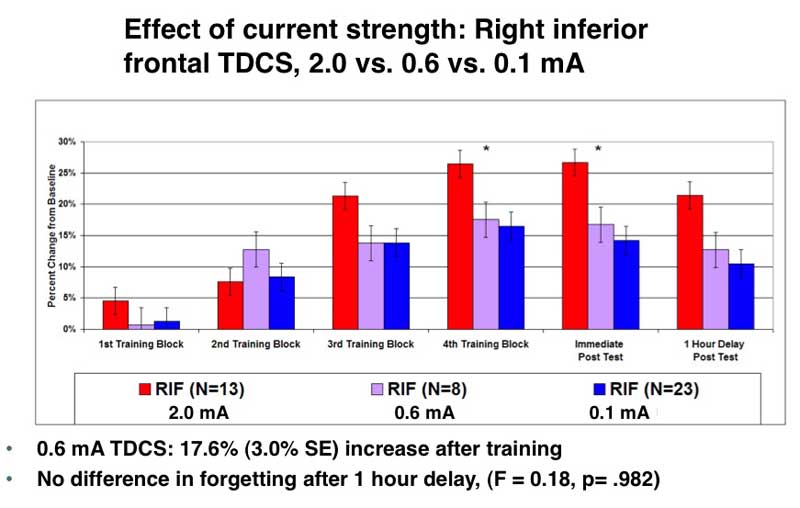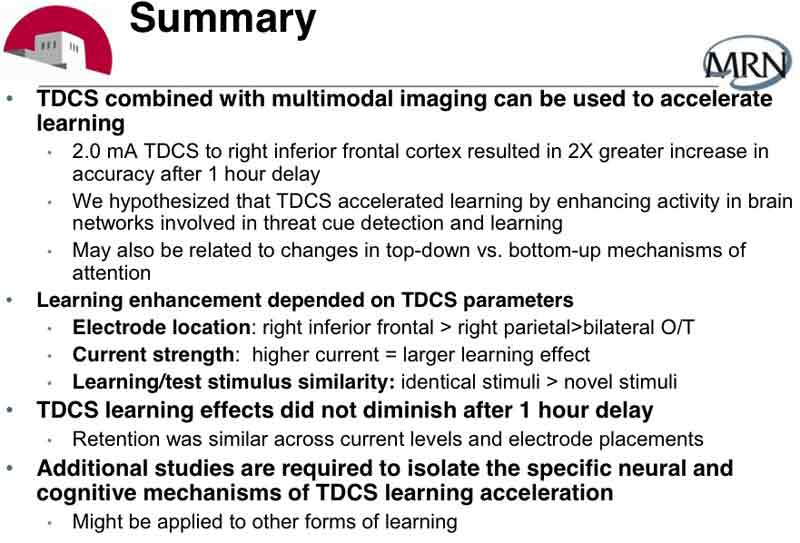From (I believe) a talk in 2010 given at the Organization for Human Brain Mapping by Dr. Vince Clark, director of the Clinical Neuroscience Center at the University of New Mexico (and previously, director of the Mind Research Network). The slides reference a study where tDCS was used in training subjects to accurately detect hidden and camouflaged objects, as in a military setting. What caught my eye, something I don’t recall seeing anywhere else, is the comparison of effectiveness of different amounts of current. It begs the question: If 2 mA is more effective than 1 mA, what about 3 mA? [As Peter points out in his comment, the chart actually contrasts effects of 2 mA and 0.1 mA as a control. I do still think it’s a good question: Why 2 mA?]. Much I don’t understand in the slides without the talk to go along with, but have a look pdf, Quick View. And a link (abstract) to what appears to me a follow-up study. P.S. After tracking all this down I can’t tell you how frustrating it is to not be able to access the full texts of these studies, especially when we (NiH, DOD) paid for them. If you can get me a copy I would
greatly appreciate it.



Here it states that the stimulation was given on right inferior frontal. No, I am studying the tdCS placements for 6 months now and this is the first time that I see that stimulation on right hemisphere gives results. This is totally opposite to all other placements where the left hemisphere is stimulated.
I mean, stimulating right hemisphere even makes more sense because it is the right hemisphere which is in charge for logical deduction and analysis.
What do you think? Did you see stimulations on the right-hemisphere giving results before?
It does seem like most of the research using f10 anode, is/was coming out of the Vince Clark and Michael Weisend DARPA research. They both swear by it (and as I understand, continue to get funding for their research – though they no longer work together afaik). The problem for me is in the notion of ‘results’. I had trouble coming up with real-world applications for enhanced ‘Where’s Waldo’ skills. Not to mention, how to measure the results in a non-lab situation. Did you listen to my interview with Michael Weisend? https://www.diytdcs.com/2013/03/michael-weisend-mind-research-network-diytdcs-podcast-4/
Thank you for putting together all this information on TDCS. I watched the Through the Wormhole episode on the subconscious mind. The section on the Mind Research Network researcher using a iontophoresis delivery unit to stimulate the test subject to speed up their recognition training was proof that this technology works. These iontophoresis delivery units can be purchased from the Internet for less than $350. I found out that you do not need a prescription if your using the unit for treating animals, such as horses.
Thank You for your comment. I’m keeping an eye out for an iontophoresis unit. I hadn’t seen that Wormhole episode but found a good chunk of it on YT. Going to post it now. Thanks. Be sure to check out the tDCS sub reddit too. Some good information circulating there. http://reddit.com/r/tdcs
Actually, the article compares 0.1 mA with 2 mA; the 0.1 mA is used as a control. Overall, tDCS is more complicated than just ‘increasing the juice’, and both the safety and efficacy of using 3.0 mA is unknown. Probably unwise to carry out that experiment on yourself.
Thanks Peter. I did read it wrong. I hope I wasn’t suggesting to anyone they should try upping the juice. I’m just wondering out loud how it came to be that 2 mA is the usual dosage. I’m not currently(!) self-experimenting.